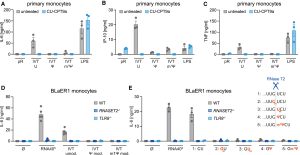By 2025, cumulative global mRNA vaccine vaccinations have exceeded 10 billion doses, and their efficacy and safety have completely rewritten the landscape of infectious disease prevention and control. From COVID-19 vaccines to cancer treatment, mRNA technology is permeating the medical field at an astonishing speed. However, looking back to 2005, the research team led by scientist Karikó first discovered that replacing uridine (U) in mRNA with pseudouridine (Ψ) could significantly reduce immunogenicity, a finding that became the “Archimedean fulcrum” of mRNA therapy. But why can Ψ-RNA evade the immune system’s security checks?
Toll-like receptors 7/8 (TLR7/8) in the immune system act like “nucleic acid detectors,” which specifically recognize degraded viral RNA products to trigger inflammatory responses. In contrast, the body’s own RNA, due to modifications such as Ψ, can “evade detection.” This phenomenon not only explains the low immunogenicity of mRNA vaccines but also reveals the sophisticated mechanism of self-non-self recognition in the evolution of life.
Recently, a research report titled “Pseudouridine RNA avoids immune detection through impaired endolysosomal processing and TLR engagement” published in the international journal Cell stated that scientists from institutions such as the University of Munich have, for the first time through research, discovered that the “invisibility trick” of Ψ-RNA stems from the “selective blindness” of lysosomal nucleases RNase T2 and PLD exonucleases, as well as the “double neglect” of TLR7/8 receptors.
The success of mRNA therapy relies on the immune-silencing property of Ψ modification, but its molecular mechanism has long been a mystery. In this study, researchers aimed to reveal how Ψ-RNA achieves immune evasion through the dual checkpoints of lysosomal processing and TLR recognition, thereby providing a theoretical basis for the design of safer RNA drugs.
In the study, researchers used in vitro transcribed Ψ-RNA, m1Ψ-RNA (N1-methylpseudouridine), and unmodified RNA as models, combined with human monocytes, dendritic cells, and TLR8/7 knockout cell lines, to systematically evaluate differences in immune activation. Key reagents used in the study included RNase T2, PLD3/4 exonucleases, and TLR-specific inhibitors (such as CU-CPT9a).

Fig.1 Ψ RNA does not activate TLR8.1
The study found that the cleavage efficiency of RNase T2 on Ψ-RNA was reduced by over 90% compared to unmodified RNA, and PLD exonucleases also struggled to degrade Ψ-RNA. In cell models, Ψ-RNA barely activated TLR7/8-dependent inflammatory factors (such as IL-6 and IFN-α), while m1Ψ-RNA could weakly activate TLR8 but was still significantly weaker than unmodified RNA.
Further research using nuclear magnetic resonance (NMR) revealed that Ψ-RNA tends to form an A-type helical conformation, which prevents it from fitting into the B2 binding pocket of RNase T2. Meanwhile, methylation at the N1 position of Ψ further hinders the binding of PLD exonucleases.
The immune silencing of Ψ-RNA is not a single mechanism but a double insurance. On one hand, RNase T2 and PLD exonucleases cannot effectively cleave Ψ-RNA, thereby hindering the generation of TLR7/8 ligands; on the other hand, the first binding pocket of TLR8 ignores Ψ, and the second binding pocket of TLR7 rejects Ψ-RNA fragments.
In this study, researchers systematically revealed the molecular details of Ψ-RNA’s immune evasion for the first time, and its significance extends far beyond the field of mRNA vaccines. Ψ modification may be a self-marker evolved by eukaryotes, which can avoid autoimmune attacks by interfering with the recognition of nucleases and TLRs. This discovery not only consolidates the foundation of mRNA therapy but also provides a new idea of “precisely regulating immunogenicity” for RNA drug design.
Although m1Ψ retains partial TLR8 activation ability, its immunogenicity is still much lower than that of unmodified RNA, suggesting that future RNA drugs may balance efficacy and safety by fine-tuning modification sites. The combination of LC-MS and NMR provides a high-resolution tool for RNA modification research, which is expected to decipher the mechanisms of more immune stealth modifications (such as 2′-O-methylation) in the future.
As the researchers stated: “Understanding how Ψ-RNA fools the immune system is like deciphering the ‘invisibility cloak’ of the RNA world; the next vaccine revolution may lie in the next Ψ.”
Creative Biolabs offers a series of professional Custom mRNA Modification Services, which mainly include two major categories:
mRNA 5′ Capping Services: This service focuses on the modification of the 5′ end of mRNA, offering multiple capping options. Specific options include:
Nucleotides Modification Services: This service aims to chemically modify the nucleotides within the mRNA strand. The specific modification types offered include:
- Pseudouridine Modification
- 2-Thiouridine Modification
- 5-Methylcytidine Modifiation
- N6-Methyladenosine Modification
Reference
Bérouti, Marleen, et al. “Pseudouridine RNA avoids immune detection through impaired endolysosomal processing and TLR engagement.” Cell (2025). https://doi.org/10.1016/j.cell.2025.05.032
